1993 CHEVROLET LUMINA heating
[x] Cancel search: heatingPage 175 of 324
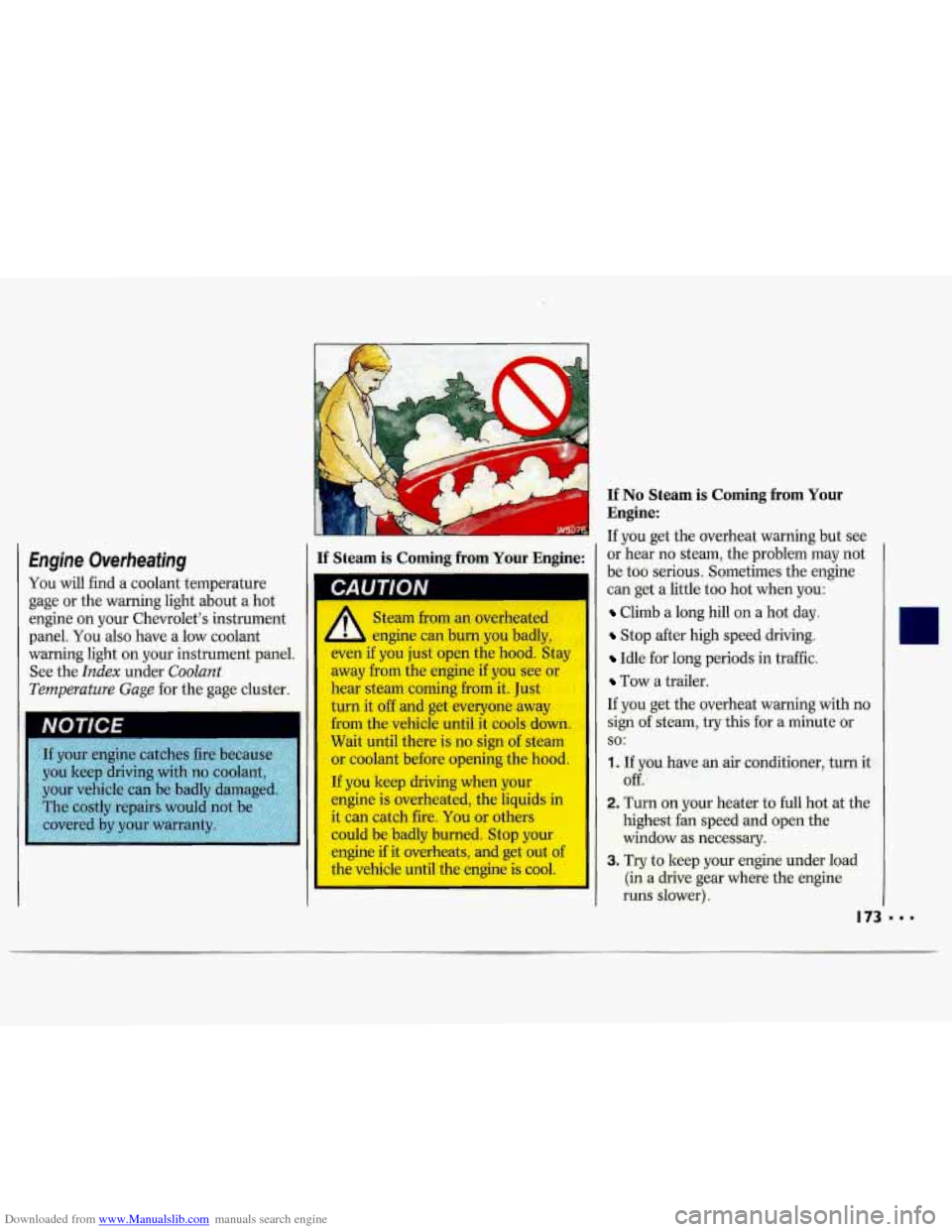
Downloaded from www.Manualslib.com manuals search engine If No Steam is Coming from Your
Engine:
If you get the overheat warning but see
or hear no stem, the problem may not
be
too serious. Sometimes the engine
can get
a little too hot when you:
Climb a long hill on a hot day.
Stop after high speed driving.
Idle for long periods in traffic.
Tow a trailer.
If you get the overheat warning with no
sign of steam, try this for a minute or
1. If you have an air conditioner, turn it
so:
Off.
I If Steam is Coming from Your Engine:
’I
Engine Overheating
You will find a coolant temperature
gage or the warning light about a hot
engine on your Chewolet’s instrument
panel. You also have a low coolant
warning light on your instrument panel.
See the
Index under Coolant
Temperature Gage for the gage cluster. Steam from
an overheated
engine can burn you badly,
/I‘ even if you just open the hood. Stay
away from the engine if you see or
hear steam coming from it. Just
turn it
off and get everyone away
from the vehicle until it cools down.
Wait until there is no sign of steam
or coolant before opening the hood.
If you keep driving when your
engine
is overheated, the liquids in
it can catch fire. You or others
could be badly burned. Stop your
engine
if it overheats, and get out of
the vehicle until the engine
is cool.
2. Tm on your heater to full hot at the
I I highest fan speed and open the
window as necessary.
3. Try to keep your engine under load
(in a drive gear where the engine
I runs slower). IL
Page 176 of 324
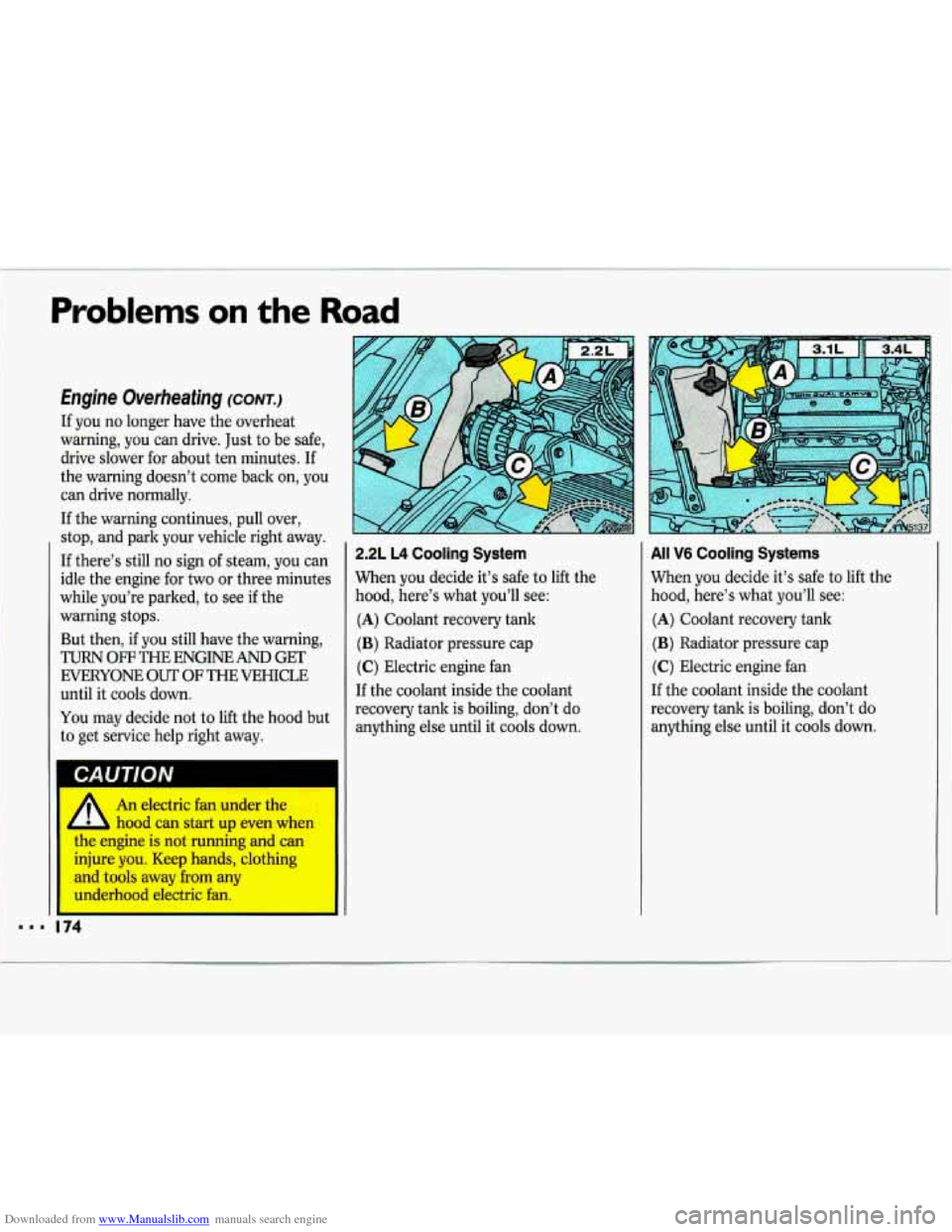
Downloaded from www.Manualslib.com manuals search engine .- I
Problems on the Road
hgine Overheating (CONT.)
If you no longer have the overheat
warning, you can drive. Just to be safe,
drive slower for about ten minutes.
If
the warning doesn’t come back on, you
can drive normally.
If the warning continues, pull over,
stop, and park your vehicle right away.
If there’s still
no sign of steam, you can
idle the engine for two or three minutes
while you’re parked, to see
if the
warning stops.
But then, if you still have the warning,
TURN OFF THE ENGINE AND GET
EVERYONE
OUT OF THE VEHICLE
until it cools down.
You may decide not to lift the hood but
to get service help right away.
LAU I IVN
2.2L L4 Cooling System
When you decide it’s safe to lift the
hood, here’s what you’ll see:
(A) Coolant recovery tank
(B) Radiator pressure cap
(C) Electric engine fan
If the coolant inside the coolant
recovery tank is boiling, don’t do
anything else until it cools down.
All V6 Cooling Systems
When you decide it’s safe to lift the
hood, here’s what you’ll see:
(A) Coolant recovery tank
(B) Radiator pressure cap
(C) Electric engine fan
If the coolant inside the coolant
recovery tank is boiling, don’t do
anything else until it cools down.
I
Page 180 of 324
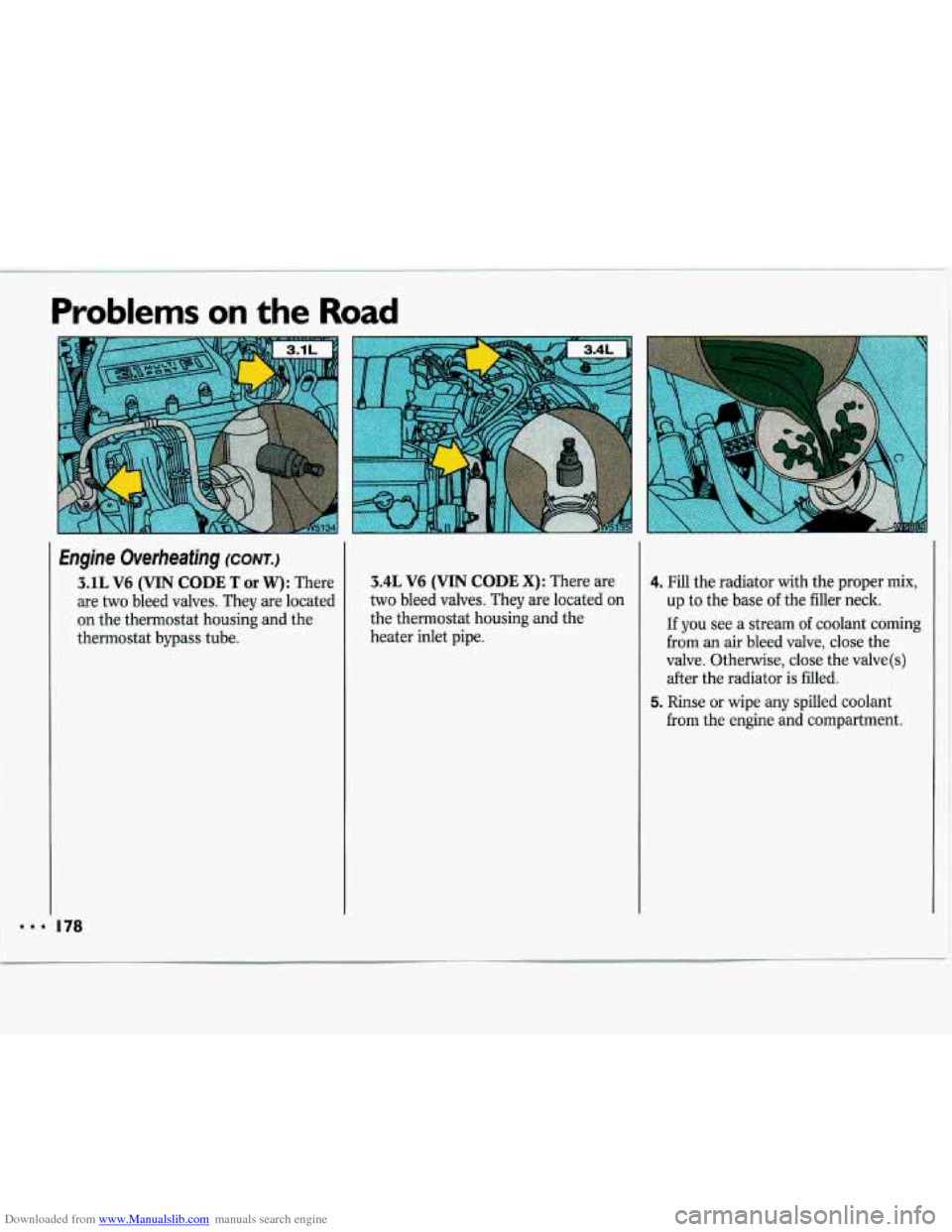
Downloaded from www.Manualslib.com manuals search engine ...
Problems on the Road
Engine Overheating (CONTJ
3.1L V6 (VIN CODE T or W): There
are two bleed valves. They are located
on the thermostat housing and the
thermostat bypass tube. 3.4L V6 (VIN CODE X): There are
two bleed valves. They are located
on
the thermostat housing and the
heater inlet pipe.
I
4. Fill the radiator with the proper mix,
up to the base of the filler neck.
If you see a stream of coolant coming
from an air bleed valve, close the
valve. Otherwise, close the valve(s)
after the radiator is filled.
5. Rinse or wipe any spilled coolant
from the engine and compartment.
I78
Page 182 of 324
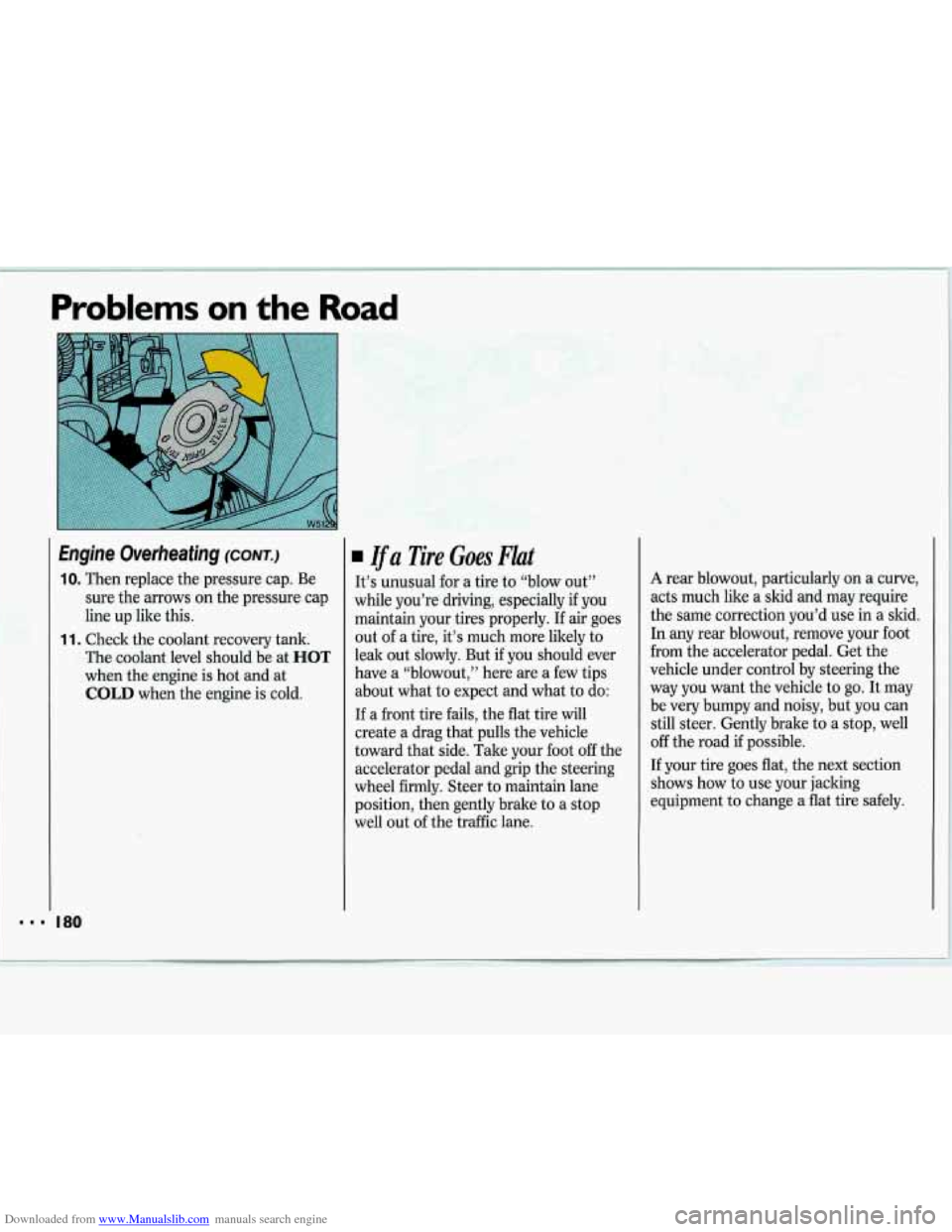
Downloaded from www.Manualslib.com manuals search engine Problems on the Road
Engine Overheating (CONT.)
10. Then replace the pressure cap. Be
sure the arrows on the pressure cap
line up like this.
1 1. Check the coolant recovery tank.
The coolant level should be at
HOT
when the engine is hot and at
COLD when the engine is cold.
- i: .:-
Ifa Tire Goes Flat
It’s unusual for a tire to “blow OU~,)
while you’re driving, especially if you
maintain your tires properly. If air goes
out of a tire, it’s much more likely to
leak out slowly. But
if you should ever
have a “blowout,” here are a few tips
about what to expect and what to do:
If a front tire fails, the flat tire will
create a drag that pulls the vehicle
toward that side. Take your foot
off the
accelerator pedal and grip the steering
wheel firmly. Steer to maintain lane
position, then gently brake to a stop
well out of the traffic lane.
A rear blowout, particularly on a curve,
acts much like a
skid and may require
the same correction you’d use in a
skid.
In any rear blowout, remove your foot
from the accelerator pedal. Get the
vehicle under control by steering the
way you want the vehicle to go. It may
be very bumpy and noisy, but you can
still steer. Gently brake to a stop, well
off the road if possible.
If your tire goes flat, the next section
shows how
to use your jacking
equipment to change a
flat tire safely.
Page 213 of 324

Downloaded from www.Manualslib.com manuals search engine How to Check
The proper fluid should be added if the
level does not reach the bottom of the
diaphragm when it’s
in place in the
reservoir. See the instructions on the
reservoir cap.
Engine Coolant
The following explains your cooling
system and how to add coolant when it
is low. If you have a problem with
engine overheating or
if you need to add
coolant to your radiator, see the
Index
under Engine Overheating.
The proper coolant for you1 ~ ~ ~ _et
will:
Give freezing protection c, .m to
Give boiling protection up to 262°F
Protect against rust and corrosion.
Help keep the proper engine
Let the warning lights work as they
What to Use:
Use a mixture of one-half clean water
(preferably distilled) and one-half
antifreeze that meets
“GM Specification
1825-M,” which won’t damage ,
-34°F (-37°C).
(128°C).
temperature. should. aluminum
parts. You can
also use a
recycled coolant conforming to
GM
Specification 1825-M with a complete
coolant flush and refill. If you use this
mixture, you don’t need to add anything
else.
I
9
Adding only plain water to
your cooling system can be
dangerous. Plain water, or some
other liquid like alcohol, can boil
before the proper coolant mix will.
Your vehicle’s coolant warning
system is set for the proper coolant
mix. With plain water or the wrong
mix, your engine could get too hot
but you wouldn’t get the overheat
warning. Your engine could catch fire and you or others could be
burned. Use a
50/50 mix of clean
water and a proper antifreeze.
Page 216 of 324
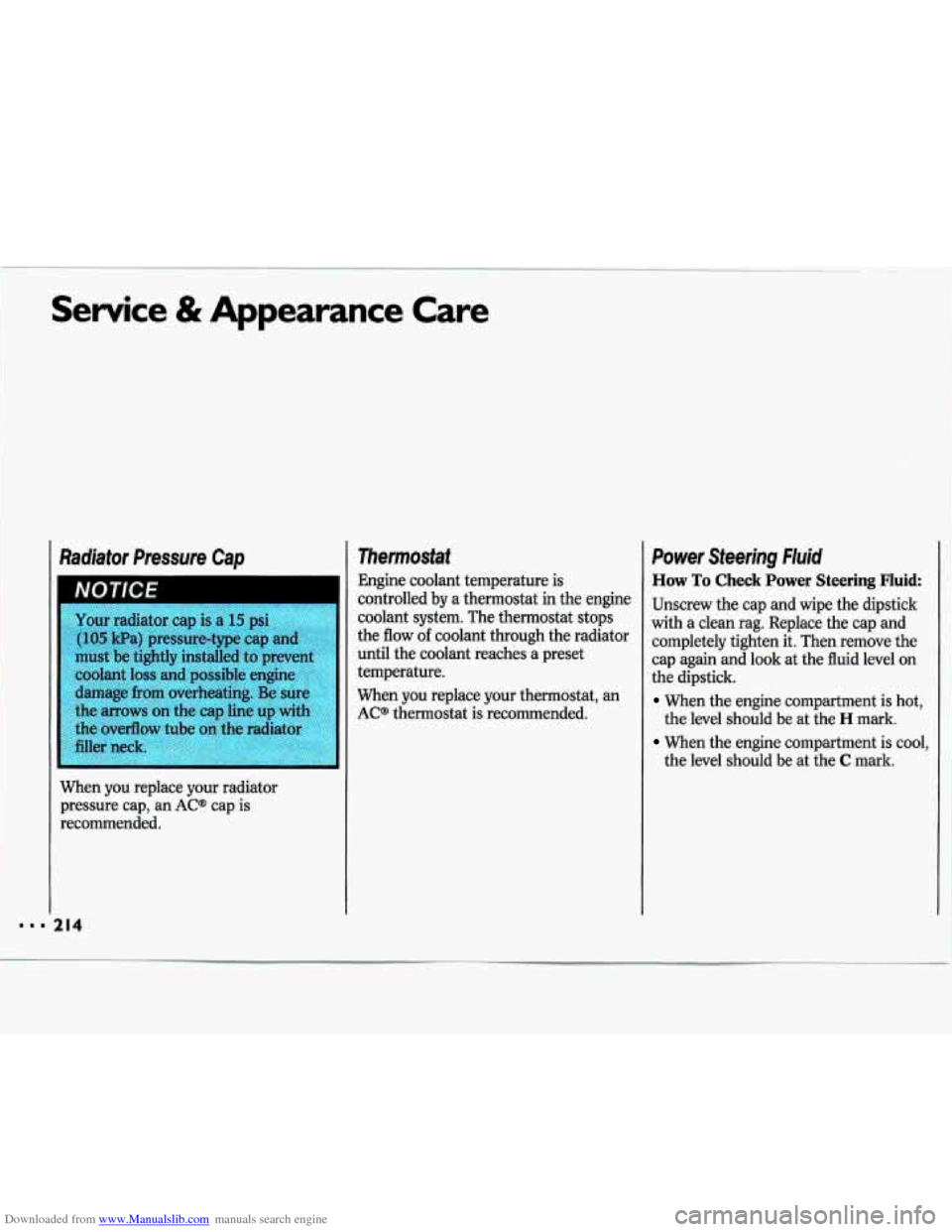
Downloaded from www.Manualslib.com manuals search engine Service & Appearance Care
Radiator Pressure Cap
214
Your radiator cap is a 15 psi
(105 Wa) pressure-type cap and
must be tightly installed to prevent
coolant loss and possible engine
damage
from overheating. Be su
the arrows on the cap line up wi
the overflow tube on the radiato
filler neck.
When you replace your radiator
pressure cap, an
AC@ cap is
recommended.
Thermostat
Engine coolant temperature is
controlled by a thermostat in the engine
coolant system. The thermostat stops
the flow
of coolant through the radiator
until the coolant reaches a preset
temperature.
When you replace your thermostat, an
AC@ thermostat is recommended.
Power Steering Fluid
How To Check Power Steering Fluid:
Unscrew the cap and wipe the dipstick
with a clean rag. Replace the cap and
completely tighten it. Then remove the
cap again and look at the fluid level
on
the dipstick.
When the engine compartment is hot,
When the engine compartment is cool,
the
level should be at the
H mark.
the level should be at the
C mark.
Page 227 of 324
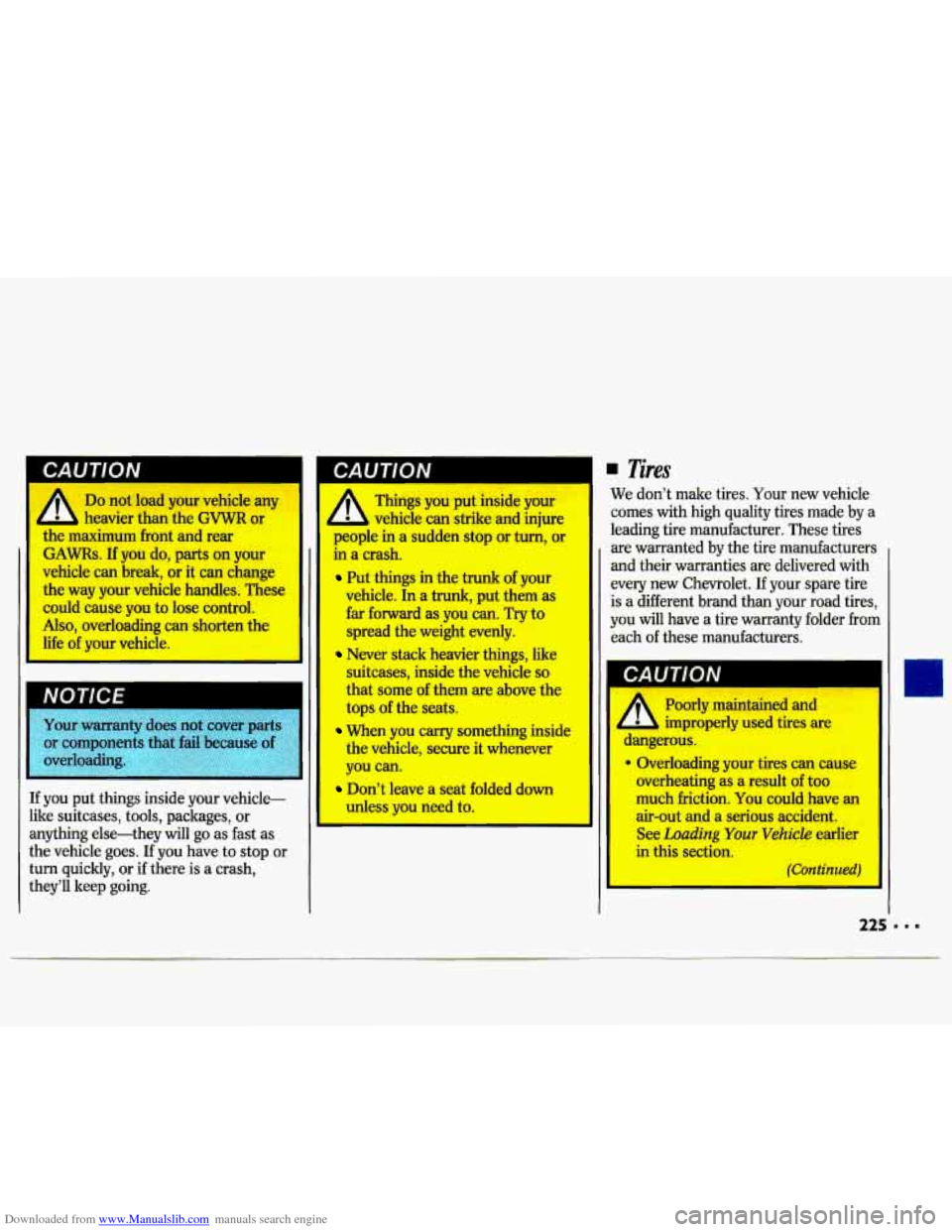
Downloaded from www.Manualslib.com manuals search engine A
Do not load your vehicle any
Things you put inside your
heavier than the
GVWR or b vehicle can strike and iniure
the maximum front and rear
GAMS. If you do, parts on your
vehicle can break, or it can change
the way your vehicle handles. These
could cause you to lose control.
Also, overloading can shorten the
life of your vehicle.
‘I I
If you put things inside your vehicle-
like suitcases, tools, packages, or
anything else-they
will go as fast as
the vehicle goes. If you have
to stop or
turn quickly, or if there is a crash,
they’ll keep going. people
in a sudden
stop or turn, or
in a crash.
Put things in the trunk of your
vehicle. In a trunk, put them as
far forward
as you can. Try to
spread the weight evenly.
Never stack heavier things, like
suitcases, inside the vehicle
so
that some of them are above the
tops
of the seats.
When you wry something inside
the vehicle, secure it whenever
you can.
Don’t leave a seat folded down
unless
you need to.
. Tires
We don’t make tires. Your new vehicle
comes with high quality tires made by a
leading tire manufacturer. These tires
are warranted
by the tire manufacturers
and their warranties are delivered with
every new Chevrolet. If your spare tire
is a different brand than your road tires,
you will have a tire warranty folder from
each of these manufacturers.
A Poorly maintained and
dangerous.
I improperly used tires are
9 Overloading your tires can cause
overheating as a result of too
much friction. You could have an
air-out and a serious accident.
See Loading Your Vehicle earlier
in this section.
(Continued)
Page 312 of 324

Downloaded from www.Manualslib.com manuals search engine 310
Braking in Emergencies ................... 131
“BreakIn,” New Vehicle
Braking Technique
........................... 126
Normal Driving
................................ 51
When Towing a Trailer .................. 155
Buckling Up (see
Safety Belts)
Bulb Replacement
Back-up Light
................................ 223
Center High-Mounted Stoplight
............................... 221, 251
Front Park and Turn Signal ........... 220
Front Sidemarker
........................... 221
Headlight
............................... 219, 251
Taillight
.................................. 222, 251
. C apacities and Specifications ....... 247
Carbon Monoxide in
Exhaust
............................... 67, 68, 153
Cassette Tape Player (see
Audio Systems)
Center Lap Belts (see Safety Belts)
Chains, Tire ............................ 187, 231
Changing a Flat Tire
......................... 181 Checking
Brake Fluid
.................................... 216
Engine Coolant
.............................. 173
Engine
Oil ...................................... 201
Hydraulic Clutch Fluid
.................. 210
Power Steering Fluid
..................... 214
Safety Belt Systems
.......................... 41
Things Under the Hood ................. 196
Transaxle Fluid Automatic
..................................... 206
Manual .......................................... 209
Child Restraints .................................. 30
Children ............................................. 29
Cigarette Lighter
................................ 82
Circuit Breakers
& Fuses ................ 241
City Driving ..................................... 143
Cleaner, Air
............................. 205, 254
Cleaning
Aluminum Wheels ......................... 237
Antenna
......................................... 114
Cassette Player and Tapes
............. 113
Compact Discs ............................... 114
Fabric .............................................. 233
Fiberglass Springs
........................... 239
Glass
............................................... 236
Inside of Your Chevrolet ................ 233 Outside
of Your Chevrolet
............. 236
Safety Belts
.................................... 235
Special Problems
........................... 234
Stains
.............................................. 234
Underbody Maintenance
............... 238
Vinyl or Leather
.............................. 235
Warnings ......................................... 232
Weatherstrips
................................. 237
White Sidewall Tires
..................... 237
Windshield and Wiper Blades
...... -236
Clock, Setting the
............................ 103
Clusters, Instrument Panel ............... 86
Clutch, Hydraulic
Adding Fluid
.......................... 210, 249
Checking Fluid
............................... 210
Air Conditioning
............................... 99
Heating .............................................. 98
Ventilation ...................................... 102
Compact Disc Player (see
Audio Systems)
Compact Spare Tire ......................... 187
Compartments, Storage ..................... 82
Console Storage Armrest
................... 82
Control of a Vehicle .......................... 125
Convenience Net ............................... 50
Comfort Controls